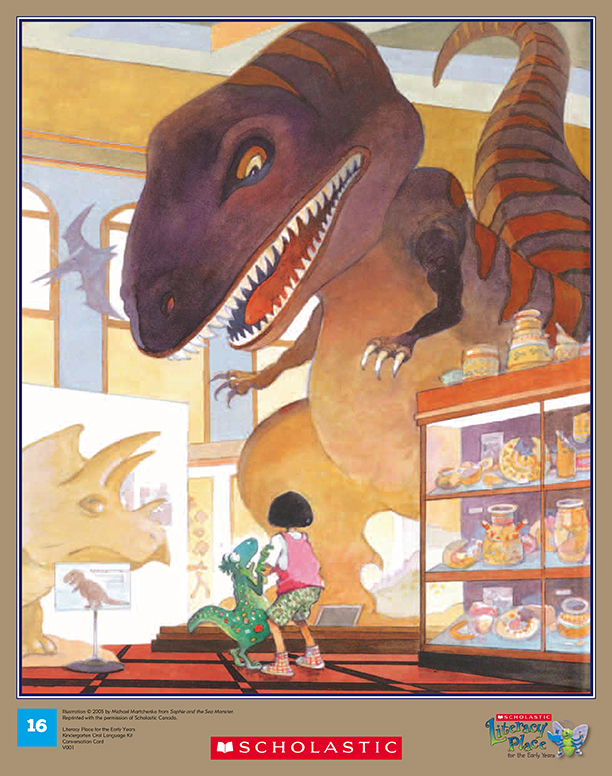Oral Language Teaching Strategy:
Offer Prompts and Frameworks to Reluctant Talkers Offer encouragement, low-key prompts, and adequate thinking time to elicit conversation from shy students.
Time: one 30-minute lesson or two 15-minute lessons
Materials: Art Card #16
Grouping: whole class or small group
Assessment:
Kindergarten Oral Language Assessment Scale
FOCUSING ON THE PICTURE
[Analyzing/inferring]-
Tell me what is going on in this picture. What do you see that makes you say that?
Show students the picture. Tell them it is an illustration by Michael Martchenko found in a book called Sophie and the Sea Monster. Ask them to look at it and think about what they see and what they think is happening.
Teaching Tip: Provide reluctant speakers with a simple scaffold such as, “I can see…”
- Offer prompts to stimulate discussion:
- What place is shown in this picture? (Provide ‘museum’ as a possibility if not suggested by your students and clarify understanding of the word.)
- What details in the picture help you know what place this is?
- Do you think we can see Sophie and the sea monster in the picture?
- Tell me about the dinosaurs you see. How many are there? What colour are they? How big are they?
- Do you think these dinosaurs are real or models? What makes you say that?
- Why do you think the girl and the sea monster are in a museum? What might they be doing there?
- Invite students to notice the colours in the illustration.
- Invite students to notice the size of the objects in the illustration.
Look at the colours in the picture. Do you notice some colours more than others?
What did Michael Martchenko make really big in the picture? What do you see that is small?
Teaching Tip: Focusing on attributes such as number, colour, and size provides support for reluctant speakers.
GOING DEEPER
[Inferring/evaluating]- Offer prompts that focus the students on the emotions portrayed:
- How is the sea monster feeling?
- How is Sophie feeling? What makes you think that?
- What words could you use to describe the biggest dinosaur, the Tyrannosaurus Rex? Is it scary? angry?
- What did Michael Martchenko do to make the T-Rex look this way? (Provide prompts, if needed, to focus on the size, dark colours, and facial details and compare these with the small dinosaurs in the background.)
We can’t see Sophie’s face. Show me the expression you think might be on her face. What word could we use to describe the feeling that Lily is showing us?
- Discuss reasons why the characters might be in a museum.
We can’t tell from the picture so it’s OK for us to all have different ideas. You might say ‘I think Sophie is there because…’
You may conclude the lesson at this point and do the second part on the next day, or you may decide to continue and do Connecting and Predicting as part of the first lesson.
CONNECTING
Teaching Tip: If you decide to do Connecting and Predicting on the second day, begin your lesson by reviewing the picture with the students.
[Making connections]- Ask students to connect to their personal knowledge and prior experiences. Prompts might include:
- How would you feel if you were in this museum? Show me the expression that would be on your face.
- What would you tell the girl in this picture?
- Have any of you been to a museum before?
- Is there something you would like to see in a museum?
PREDICTING
[Predicting]- Ask students what they think the girl will do next and to share their idea with a partner. Invite a few students to share their partner’s idea with the group.
Tell us what your partner said. You can start this way: “Jason said the girl will…”
LESSON EXTENSIONS
-
Use the picture as the basis for a shared writing lesson. Brainstorm ideas with the students and interactively write speech bubbles to show what the characters might be saying in the scene.
- Use the shared writing account as a shared reading text and reread with the students.
FOLLOW-UP IN CENTRES
-
Locate Sophie and the Sea Monster and/or other books with illustrations by Michael Martchenko and place them in the reading centre.
-
Place other books (both fiction and non-fiction) with illustrations of dinosaurs in the reading centre and ask students to choose a favourite illustration. Students may share their selections with the class. This may provide an opportunity to discuss the differences between realistic illustrations compared to fanciful illustrations.
-
Encourage students to draw their own picture of a dinosaur and write a brief description about its size and colouring.
-
Students can experiment with proportion in their drawings by drawing themselves in a picture with a large object (e.g., elephant, building, bulldozer).

